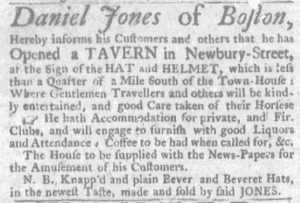What was advertised in a colonial American newspaper 250 years ago this week?

“The House to be supplied with the News-Papers for the Amusement of his Customers.”
When Daniel Jones opened a tavern “at the Sign of the HAT and HELMET” on Newbury Street in Boston, he placed an advertisement in the February 8, 1770, edition of the Massachusetts Gazette and Boston Weekly News-Letter. He listed many amenities that he provide for “Gentlemen Travellers and others,” including coffee, “good Liquors,” and “good Care” taken of their horses. Jones also indicated, “The House to be supplied with the News-Papers for the Amusement of his Customers.”
In making that pledge, Jones revealed that he offered a service available in many eighteenth-century coffeehouses and taverns. Colonists did not need to subscribe to newspapers in order to gain access to them. Instead, they could patronize establishments that maintained subscriptions expressly for the purpose of serving their clientele. Jones stated that customers at the Hat and Helmet would be bale to read “the News-Papers,” indicating that he planned to acquire more than one publication. He likely subscribed to several local newspapers, choosing among the Boston Chronicle, the Boston Evening-Post, the Boston-Gazette, the Massachusetts Gazette and Boston Post-Boy, and the Massachusetts Gazette and Boston Weekly News-Letter. Yet he probably did not limit the selection solely to local newspapers. In addition to the New-Hampshire Gazette, the Newport Mercury, the Providence Gazette, and other newspapers published in New England, he may have subscribed to newspapers printed in New York and Philadelphia or even publications from the southern colonies or London.
Circulation numbers do not tell the entire story when it comes to the dissemination of information via the colonial press in the era of the American Revolution. Jones could have subscribed for a single copy of the Massachusetts Gazette and Boston Weekly News-Letter, yet dozens of customers at his tavern may have read the issues he made available. Some patrons may not even have read the newspaper itself but instead heard portions of it read aloud at the tavern. In both cases, newspapers had a much greater reach than the number of subscribers considered alone would indicate.
